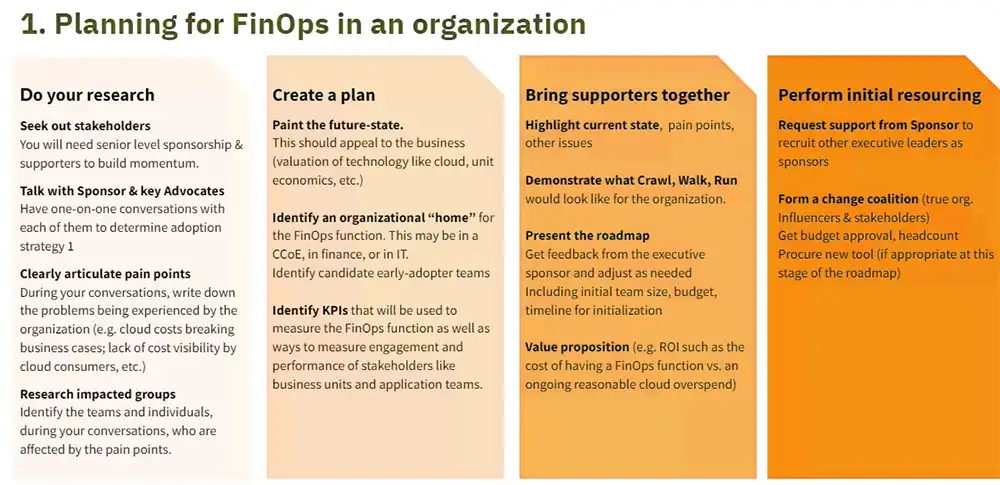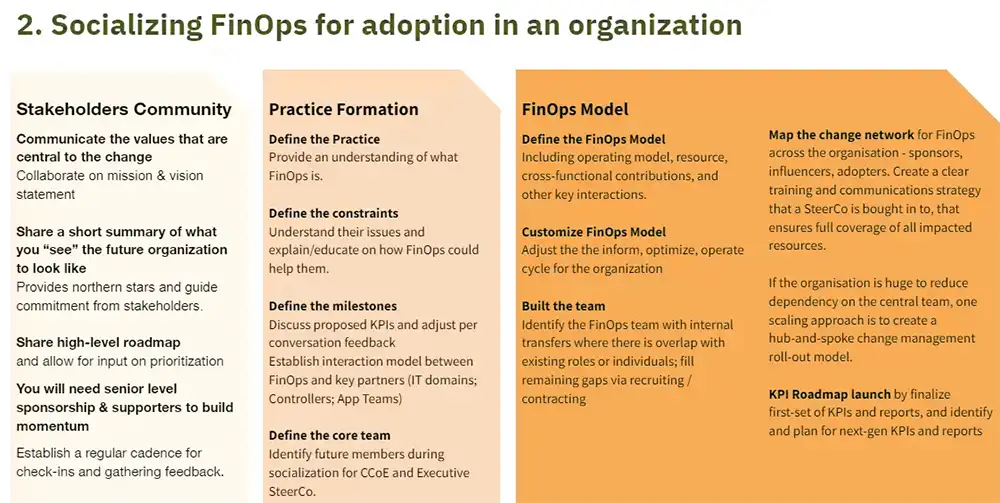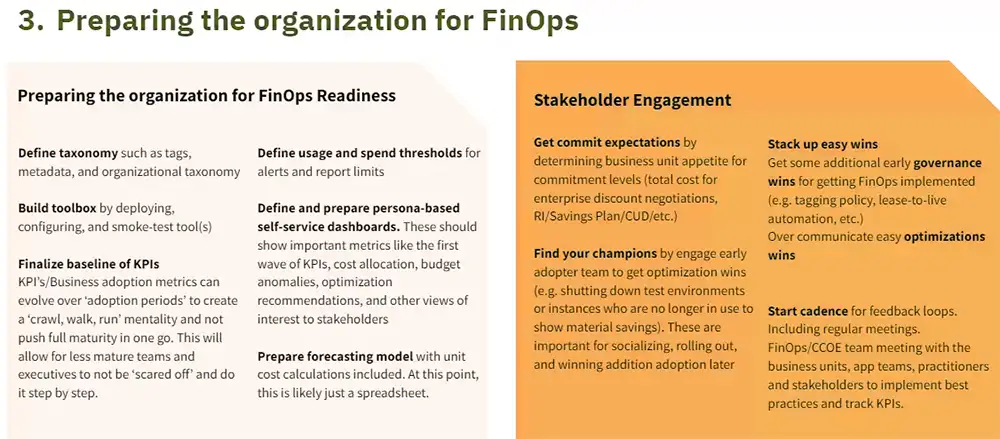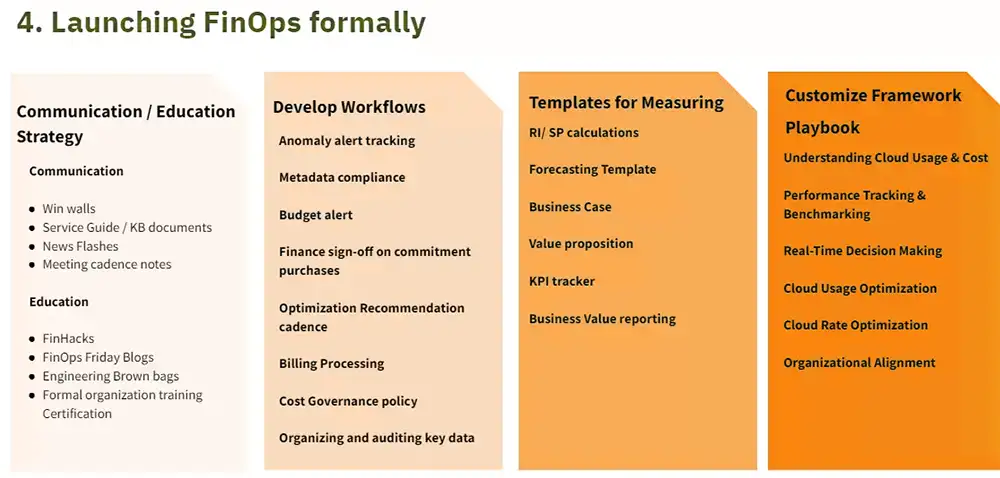Everything there is to know about FinOps

Everyone is aware that sound financial management is crucial to a company’s success, but are they given the attention they merit? FinOps is a hands-on process that takes place across departments and is essential to the financial success of your company. It is not just another “back office” task that can be ignored.
Cloud expenses have never been more scrutinized due to some of them spiraling out of control, grimacing inflation, and a potential global recession.
Already in high demand, cloud professionals are being enlisted by businesses all over the world to help them save money.
These benefits are driven by a combination of frameworks, best practices, such as AWS-Well Architected, and one of the more recent entrants, FinOps.
What is FinOps
The FinOps framework, to put it simply, recommends finance best practices for the cloud. To maximize the value of your business, you must optimize your cloud spending. This could involve, among other financial management strategies, negotiating prices with your vendors, monitoring and optimizing free trials, auditing licenses and usage, and estimating costs, to mention just some of the services that are collectively known as FInOps services.
“[FinOps] is the practice of bringing financial accountability to the variable spend model of the cloud, enabling distributed teams to make business trade-offs between speed, cost, and quality,” according to The FinOps Foundation.
The process break down of FinOps
How can you better manage your cloud spending? The three stages of the FinOps lifecycle—inform, optimize, and operate—can be used to do this.
Inform: The goal here is to make sure all interested parties have the information they require. All costs must first be allocated and converted into the metrics and dimensions that are appropriate for your company.
Optimize: The main aim here is to cut cloud costs. This can be accomplished using financial tools or by empowering engineering to design more budget-friendly infrastructure.
Operate: The processes that help scale the effort and support these practices are what operate is all about.
How to implement a FinOps program?
FinOps adoption layout
Start by investigating the difficulties that the teams and business units in your organization might be currently experiencing. Encourage teams to communicate their hurdles clearly and succinctly, mentioning how they feel other teams may be affecting them.
Finance, for instance, would gripe that engineering allocated more cloud resources than was required. Engineering may feel that finance solely cares about making money, not about offering redundancy to reduce service interruptions.
After that, put together a pilot team of engineers, financial, and C-Suite personnel to come up with a vision for what you want to achieve. At this time, it is acceptable to seek advice from a third-party consultant.
FinOps introduction to the team
The following stage is to clearly explain how implementing a FinOps framework functions in order to promote goodwill. Additionally, you’re attempting to mentally prepare everyone involved for what they’ll need to change in terms of their habits and values in order to start a cultural shift.
Constructing the FinOps
The Key Performance Indicators (KPIs) you’ll use to gauge your FinOps progress can be established during this phase.
You can also build a roadmap outlining the steps you’ll take to embrace FinOps: Crawl (to begin), Walk (to increase), and Run (mature, full-blown cost-conscious operations).
Project the FinOps
It’s time to start putting FinOps best practices to work at a sustainable pace after establishing the fundamentals, both conceptually and in terms of infrastructure changes.
First, alter the basics. Making the simple things perfect will give your team the motivation and enthusiasm they need to create more complicated workflows.
Executing the FinOps
You’ll actively put a number of FinOps principles into practice during this phase. You determine the progress, and make sure to evaluate real performance in comparison to the KPIs you previously specified.
You can reach your FinOps objectives by identifying the areas that require additional focus through constant monitoring.
Why do companies need FinOps?
IT professionals claim that switching to the cloud results in savings of around 20%. But not all activities will result in those financial savings. The businesses that gain the most are those with deliberate financial planning and governance.
In other words, without a competent FinOps organization, your business can be paying for stuff it doesn’t need, unutilized tools, and expired licenses. Even with the built-in savings of the cloud, if you aren’t paying attention, your spending can soar over time. In order to ensure that your teams are receiving the most value for the least amount of money spent, FinOps aims to emphasize constant cloud cost optimization.
Benefits of putting to use a FinOps
Why FinOps?
FinOps activities enable continuous cycles of financial improvement by giving the entire IT team visibility into application-related expenditures. The tracking of these indicators performs benchmarking to determine whether the amount of resources is adequate or excessive and alerts you to costs and needs in real time.
As various business managers have already attested, typically, depending on the workload, computing resources becomes inactive during certain windows. A straightforward strategy, like “pausing” computing resources after business hours, for example, can reduce your monthly expenditure by double-digit percentages.
The manager enters the picture as a result of the perception of these excesses. The manager optimizes services and, with the aid of FinOps, decides to remove those that are not required, anticipating the seasonal contracting of software, bandwidth, and server capacity, things that are essential for the service to be performed, and ensuring the flexibility with elasticity, speed, and reliability, which is ideal for your business.
Benefits of using a FinOps
It is possible to highlight certain other optimizations in addition to the benefits of adopting FinOps, which include achieving synergies between the various departments of the businesses, such as:
- Accurate understanding of the cost policy: Since it is possible to divide the costs of each department within the organization, it is simpler to distribute expenses so that each person is in charge of their own consumption;
- Consumption based on capacity: almost as a result of the first optimization, it is possible to establish a consumption strategy X need X capacity from the understanding of spending by area;
- Definition of the best security policy: It is no longer a secret that businesses, particularly those undergoing a digital transformation, invest heavily in security. The FinOps tool adheres to the top security standards for service providers, protecting the office environment;
- Makes it easier to implement IT organization strategies: After making more obvious cost cuts and accurately forecasting future activities, IT professionals begin to think more strategically about the company. For instance, they may consider whether the same level of service could be provided with less infrastructure;
- An analytical assessment of the environment’s state: FinOps produces thorough reports that offer a highly unified perspective of the cloud. In order to forecast the company’s overall costs in one location, dashboards can be made to highlight trends, place tags, and various other features;
- Aids in the governance of digital processes by allowing for swift decision-making and the automation of procedures to address issues, such as turning off a machine after a certain period of inactivity to save money on electricity.
FinOps Best Practices
In order to ace your FinOps program a success, here are some of the applied best practices:
- Bring together a broad team that represents all stakeholders to set the direction for FinOps.
- To gain support, pitch the advantages of FinOps to certain teams or business units. Your employees will have an incentive to get over their resistance to change as a result.
- Encourage early and frequent contact between the engineering and finance teams so they are aware of each other’s priorities and issues.
- Any time you need to increase your team’s knowledge, think about bringing in third-party professional consultants.
- Utilize powerful and user-friendly FinOps tools to automate real-time monitoring and improvement.
- Expenses per client, per deployment, and per team are examples of unit costs. By doing so, you can locate important controls, compromises, opportunities, and trade-offs that you can employ without jeopardizing efficient service delivery.
- Decide which decisions should be delegated to engineering in order to promote quicker responses to architectural challenges when a delay in responses could result in overspending.
- Encourage activities like resource right-sizing and resource termination that promote a cost-awareness culture.
FAQ
What is the difference between FinOps and DevOps?
Combining development and operations, DevOps emphasizes automation, dismantling organizational silos, teamwork, and “shifting left,” which entails identifying and resolving possible technical issues before they become problems.
FinOps utilizes a variety of tools and, like DevOps, attempts to shift cultures and practices. FinOps, on the other hand, focuses on increasing engineering cost effectiveness while DevOps stresses producing high-quality software quickly.
Why FinOps is different for SaaS-based organizations?
In contrast to other business models, the function of FinOps is different in a SaaS company. This is because volatility can vary greatly from month to month, especially in startups and early-stage businesses.
Due to this instability, the SaaS FinOps team is in charge of three key areas:
- Transforming financial transactions into business transactions
- Keeping track of the company’s financial position
- Making financial preparations in advance
Your FinOps team also needs to be able to forecast your future cash position in addition to the aforementioned. In SaaS, it’s important to model both new business revenue and revenue from ongoing contracts and anticipated renewals.
The billing schedules for your business should also be well-understood by FinOps teams, particularly those in finance. You cannot make financial projections for the future without a precise understanding of when revenue will be coming in the door.
Challenges
Spreadsheets and finance software are frequently pieced together in early-stage businesses as a faster way to manage financial operations. However, the manual procedures needed for this configuration produce financial records that are inconsistent or inaccurate. Before you know it, FinOps debt has been generated. The gaps in your system eventually turn into an administrative nightmare, and you are at a loss as to how to escape it while also managing to keep your company surviving.
This not only gives a false impression of a company’s financial standing, but it also raises serious concerns among prospective investors.
Waiting too long to make the transition from cash-based accounting to accrual-based accounting is another common issue that early-stage SaaS companies have. You cannot maintain GAAP compliance without an accrual mechanism to handle various streams of recurring revenue.
You don’t want to have to start your financial operations from scratch. Your finances will become more complicated and the transition process will take longer the longer you continue to operate using a cash-based account method.
Top solutions to get started with FinOps
CloudZero
For the C-Suite, product teams, finance, engineering, the board, and even investors, CloudZero offers precise, detailed, and actionable cost insights.
- The costs associated with each product or software feature, deployment, environment, team, project, Kubernetes cluster, and other factors can be seen by engineers.
- Cost per customer, per product, per project, COGS, and other costs are all visible to finance.
- With the aid of indicators like COGS, gross profit, and cost per customer, management and investors can evaluate the organization’s proficiency, gross margins, and profitability.
This unit economics approach makes it possible for anybody to see where money is moving. Thus, they are able to determine precisely where to reduce wasteful spending and where to increase investment to maximize ROI.
AWS Cost explorer
All AWS clients get free access to Cost Explorer. Cost Explorer can be sufficient for you if your requirements are pretty clear and you don’t require cost visibility across complicated, variable infrastructure.
The program has dashboards, recommendations for Savings Plans, rightsizing, and cost anomaly alerts.
Founded in 2014
AWS Native Tool Category
Model of charging: Free with AWS
Best for: C Companies with rather simple billing and expenditure habits
ProsperOps
Using algorithms, cutting-edge methodologies, and continuous execution, ProsperOps autonomously orchestrates your instances to utilize the most cost-effective Savings Plans and Reserved Instances (RIs).
Another advantage is that, unlike other products, ProsperOps only charges you a portion of the savings it helps you achieve.
Founded in 2018
Category: Management of autonomous savings
Pricing structure: ($0.05 for every dollar saved on compute and $0.35 for every dollar saved on purchased/optimized converted reserved instances, as of 2/2021, per AWS Marketplace)
Best suited for: Businesses seeking a fresh, contemporary approach to AWS savings programs and reserved instances
Final words
The principles of FinOps produce measurable, long-lasting value when incorporated into or in partnership with the Cloud Center of Excellence and IT finance.
FinOps’ role goes beyond the cost impact, even though cost savings are an obvious benefit (and a necessity given the prevalence of toxic spend on enterprise cloud). Achieving financial control, predictability, and agility is the goal.





